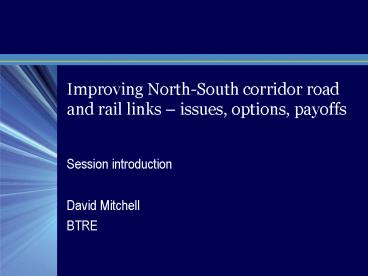Session introduction PowerPoint PPT Presentation
1 / 19
Title: Session introduction
1
Improving North-South corridor road and rail
links issues, options, payoffs
- Session introduction
- David Mitchell
- BTRE
2
Inter-capital freight movement road predominant
Note Freight estimates exclude steel
movements carried by rail and bulk freight moved
by coastal shipping, the latter includes
significant quantities of liquid fuel
transported from Westernport (Vic.) to Sydney and
Brisbane. Source BTRE 2006, Freight measurement
and modelling in Australia (Report 112).
3
Inter-capital passenger travel air predominant
Source BTRE 2007, Passenger movements between
Australian cities, 1970-71 to 2030-31
(Information Sheet 26).
4
NorthSouth corridor traffic volumes
Heavy vehicles (AADT)
Light vehicles (AADT)
5
Inter-capital road traffic a small share
Sources BTRE 2006, Freight measurement and
modelling in Australia (Report 112),
State/Territory road traffic data (2005) and
BTRE estimates.
6
BTRE-projected BAU freight growth 3.5pa (absent
significant modal shift)
Sources BTRE 2006, Freight measurement and
modelling in Australia (Report 112) and BTRE
forthcoming, Road impacts of
roadrail mode shift.
7
Projected BAU North-South freight by mode
Sources BTRE 2006, Freight measurement and
modelling in Australia (Report 112) and BTRE
forthcoming, Road impacts of
roadrail mode shift.
8
Under these assumptions, inter-capital truck
travel up 70 on average
Sources BTRE 2006, Freight measurement and
modelling in Australia (Report 112) and BTRE
forthcoming, Road impacts of
roadrail mode shift and BTRE estimates.
9
Projected North-South freight increased rail
share scenario
Sources BTRE 2006, Freight measurement and
modelling in Australia (Report 112) and BTRE
forthcoming, Road impacts of
roadrail mode shift and BTRE estimates.
10
Significant inter-capital rail mode shift, but
muted impact on total corridor truck movements
Source BTRE estimates.
11
Supporting material
12
BAU projected freight task Syd-Mel
13
BAU projected freight taskBne-Syd
14
BAU projected freight taskBne-Mel
15
Other material
16
Key issues
- Volume of freight likely to switch
- Infrastructure costs
- Benefits
- Reduced road wear
- Reduced external costs (e.g. accidents,
pollution, congestion) - Reduced shipper costs/increased service quality
17
Road-side (external) cost savings are often large
- ARTC (2001) rail audit road-side savings were X
per cent of total gross benefits - Y per cent from road wear
- Z per cent from externalities (accidents,
greenhouse, pollution) - The remaining benefits accrue to existing rail
customers - NorthSouth rail study estimated these savings
were X per cent of total gross benefits - Y per cent from road wear
- Z per cent from externalities
18
Net road-side savings may be overstated
- Life-cycle pavement cost based modelling implies
avoidable road costs between 12 c/km for heavy
vehicles on these corridors - Well below current fuel-based variable charges
(910 c/km) - External costs
- Accidents costs most significant between 15
c/km for HVs, varying with road standard and
traffic mix - Greenhouse gas emissions (_at_ A10/t CO2) between
xy c/km - Other external costs negligible for inter-capital
freight
19
Avoidable road infrastructure costs are low
- Life-cycle pavement cost based modelling implies
avoidable road costs between 12 c/km for heavy
vehicles on these corridors - Well below current fuel-based variable charges
(910 c/km) - External costs
- Accidents costs most significant between 15
c/km for HVs, varying with road standard and
traffic mix - Greenhouse gas emissions (_at_ A10/t CO2) between
xy c/km - Other external costs negligible for inter-capital
freight
20
External accident costs
- Costs imposed on third parties not otherwise
internalised. - Empirically impact of traffic volume on average
accident costs (rate) - Low HV accident rates on dual carriageway
highways ? low external accident costs - Higher HV accident rates on undivided
carriageways ? concomitant impact on external
costs
21
Net road-side impact and implications
- For most inter-capital links, including
North-South corridors - Avoidable pavement wear external costs lt
Current variable road use charge - The implication is that heavy vehicles more than
cover avoidable infrastructure and external costs - For infrastructure assessments, this implies that
the indirect impacts of rail investment is nil
(negative) - For rail projects then, the benefits within the
rail mode should at least cover the project costs
to be considered.
22
Concluding remarks
- Projected growth in North-South inter-capital
freight will be serviced by roadfreight to more
than double 20052025 - Increasing vehicle size will mitigate the growth
in vehicle numbers - Rail may increase share. However, likely to
reduce inter-capital HV traffic by less than 20 - Indirect road-side savings likely to be small

